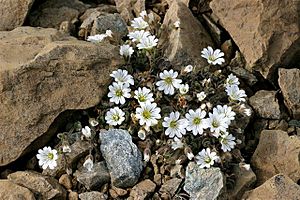Shetland mouse-ear facts for kids
Quick facts for kids Shetland mouse-ear |
|
|---|---|
 |
|
| Scientific classification | |
| Genus: |
Cerastium
|
| Species: |
nigrescens
|
The Shetland mouse-ear (also known as Cerastium nigrescens, Shetland mouse-eared chickweed, or Edmondston's chickweed) is a special type of plant. It is endemic to Shetland, Scotland. This means it only grows naturally in Shetland and nowhere else in the world!
Contents
Discovery of the Shetland Mouse-Ear
This unique plant was first found in 1837. A young botanist named Thomas Edmondston discovered it. He was only 12 years old at the time! For a long time, people thought the Shetland mouse-ear was the same as another plant called the Arctic mouse-ear. But now, most scientists agree it is its own separate species.
Where the Plant Lives
The Shetland mouse-ear is very rare. In the past, it was seen in a few places. Today, it only grows on two special hills. These hills are on the island of Unst in Shetland. The hills are made of a unique type of rock called serpentine. One of these places is called Keen of Hamar.
What the Plant Looks Like
The Shetland mouse-ear can look very different depending on the plant. Some plants might be small, with just one stem and one flower. Others can grow into a fist-sized cushion. These larger plants can have as many as 40 flowers! The flowers often look quite big compared to the rest of the plant.
How the Plant's Numbers Change
The number of Shetland mouse-ear plants can change a lot each year. Scientists are not completely sure why this happens. It might be because different numbers of seeds sprout and survive each year. Even with these changes, the total number of plants seems to stay steady over time. The areas where it grows have also stayed the same.
See also
 In Spanish: Cerastium nigrescens para niños
In Spanish: Cerastium nigrescens para niños

